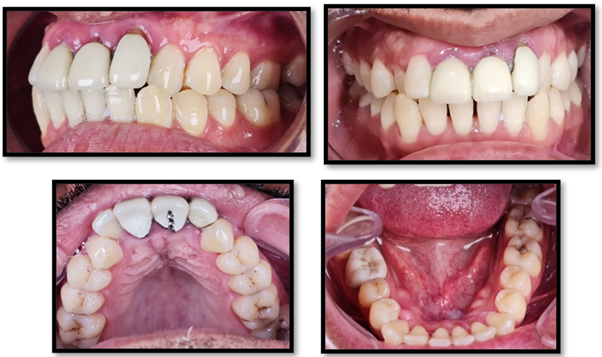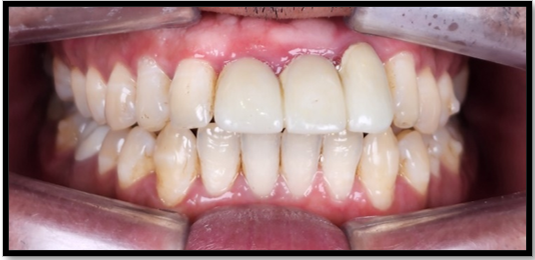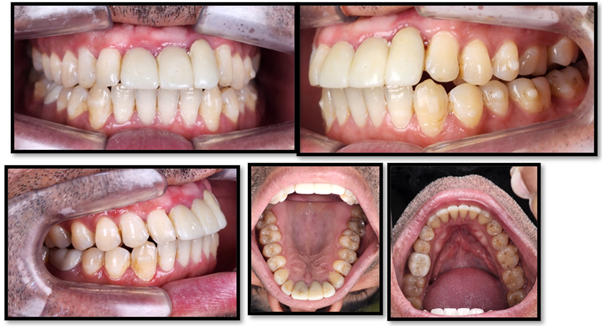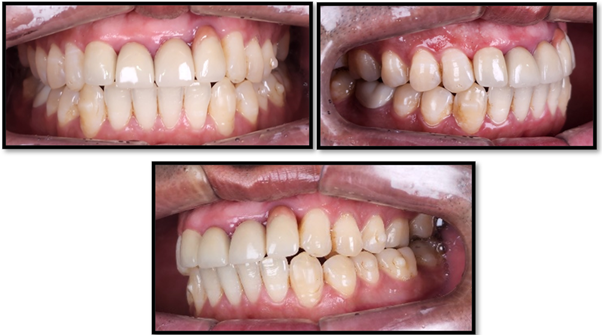Riddhi Rathi1, Isha Jain2, Kunal Sheth1 and Pratha Akolu3*
1HOD Dental at Nanavati Max Hospital, Founder and MD Orthosquare Multispeciality Dental Clinic, India
2Director at Orthosquare Multispeciality Dental Clinic, India
3Associate Dentist Orthosquare Multispeciality Dental Clinic, India
*Corresponding Author: Pratha Akolu, Associate Dentist Orthosquare Multispeciality Dental Clinic, India.
Received: August 13, 2024; Published: August 29, 2024
Citation: Riddhi Rathi., et al. “Comprehensive Interdisciplinary Management of Periodontal, Orthodontic, and Prosthodontic Challenges: A Case Report". Acta Scientific Dental Sciences 8.9 (2024):99-103.
The treatment of compromised periodontal and orthodontic conditions is a multifaceted approach that addresses both the health of the supporting structures of the teeth (periodontium) and the aesthetic concerns related to the appearance of the smile. The objectives of orthodontic therapy are to establish a good occlusion, enhance the health of the periodontium, and improve dental and facial esthetics [1]. Hence, need of the hour is to have an integrated approach where in periodontal treatment precedes orthodontic treatment to restore periodontal health [2]. Prosthodontic component is necessary to provide esthtetics a finishing touch. This case demonstrates treatment of a compromised periodontal and orthodontic case. The challenge here was the multidisciplinary synchronisation in order to achieve a coordinated treatment with the best possible aesthetic, prosthetic and functional prognosis [3]. Upon completion this case turned out to be the perfect strategic approach to treat such interdisciplinary case.
Keywords: Dental Esthetics; Periodontium; Multidisciplinary Approach; Orthodontics; Prosthodontics
A good face serves as a letter of recommendation. It's been believed for years that a person's appearance creates a lasting. The idealised appearance that the media presents has a significant influence on how our beauty-conscious society behaves and thinks [4]. In this ever fast-growing world esthetics is becoming a priority. And smile is the most important part of this esthetics.
In addition to the absence of oral disease and dysfunction, oral health also refers to a person's dento-facial self-confidence and social life. This fits the definition of quality of life provided by the WHO. A healthy periodontium along with well-fitting occlusion is esthetically pleasing when the patient smiles [1].
Malocclusion is a common finding, and the most common approach for treating various forms of malocclusions is fixed orthodontic therapy [5]. Despite the effectiveness of the fixed orthodontic therapy, maintenance of optimal oral hygiene becomes difficult. It promotes accumulation of dental biofilm which can cause serious damage to periodontium especially in already compromised periodontal health.
In recent decades, adult orthodontic patients have been able to meet their aesthetic and comfort needs with the introduction of clear aligner therapy. The foundation of this treatment consists of removable thermoplastic splints that cover every tooth and some of the gingiva's outermost layers. These splints gradually shift the teeth into their optimal positions [6]. Recent studies have revealed that periodontal health as well as the quantity and quality of plaque is better in clear aligners treatment than in fixed orthodontic therapy [7].
The loss of supporting structures and pathologic tooth migration brought on by periodontal disease are frequently manifested as proclination of the anterior teeth, uneven interdental spacing, inclination, rotation, overeruption, and extrusion [8]. Such malocclusion can cause greater susceptibility to periodontal disease, either by hampering oral hygiene practice or by causing excessive occlusal trauma. Such interplay between orthodontics and periodontics is mutually destructive. In presence of such compromised condition prosthetic rehabilitation becomes even more harmful. Hampered occlusion along with poor prosthetic rehabilitation may be one of the etiologic factors for compromised periodontal condition and vice versa.
The first step in maximising the benefits that these three distinct yet intertwined specialities can provide to one another is identifying periodontal issues that could worsen during orthodontic and prosthetic therapy and, on the other hand, those that could improve from it [9]. Therefore, an interdisciplinary approach is essential to provide a comprehensive and integrated treatment strategy, desired outcome and patient satisfaction.
Patients with periodontal disease may experience tooth migration involving single or multiple teeth. The most common symptoms may include tipping and extrusion of one or several incisors and development of single or multiple diastemas of the anterior teeth which was seen in this case.
This case study introduces the need for an interdisciplinary approach in complex dental cases involving periodontal, orthodontic, and prosthodontic involvement. The goal was to provide an adequate esthetic and functional reconstruction of the occlusion while restoring the patient’s periodontal health.
A 35-year-old male visited Orthosquare Multispeciality Dental Clinic with the chief complain of bleeding gums, concerned about esthetic alteration of his smile due to the canine placement and gaps in lower anterior teeth. The patient gave a dental history of prosthesis in 11 21 22 (Figure 1A). The initial assessment revealed severe inflammation, bleeding, recession with 22 and bilateral canine crossbite (Figure 1B). Radiographic assessment revealed bone loss in the anterior region. A comprehensive treatment plan which included periodontal flap surgery, occlusal trauma mitigation, bilateral crossbite correction and ultimately transitioning to zirconia crowns for a refined aesthetic outcome.

Figure 1: A: Old prosthesis 11-22, B: Severe gingival inflammation around the old prosthesis and bilateral canine crossbite C: Maxillary arch, D: Mandibular arch
Need of the hour is to have an integrated approach where in periodontal treatment precedes orthodontic treatment to restore periodontal health [2] which was followed in this case. Periodontal examination revealed probing depth of 7-8mm in the maxillary anterior region. Conventional periodontal flap surgery was performed from 12 to 23 under local anesthesia. Crevicular incision was given and full thickness mucoperisoteal flap was reflected followed by debridement. The flap was trimmed and sutured with 3-0 silk sutures. The patient was recalled after 7 days for follow up and suture removal followed by removal of old prosthesis and replacement with PMMA (polymethymethacrylate) temporaries from 12 to 22 (Figure 2).

Figure 2: PMMA given after periodontal treatment completion.
Orthodontic treatment should be performed under strict plaque control measures to place the teeth in a structurally balanced and functionally efficient position [2]. and hence, absolute care was taken to ensure proper oral hygiene. Orthodontic correction was started 4 weeks after the periodontal flap surgery using premium clear aligners (Flexismile, India). Orthodontic examination revealed Angle’s Class 1 malocclusion, bimaxillary protusion, bilateral canine crossbite and spacing in the lower anterior teeth. The important objective was to maintain the class 1 malocclusion while correcting the above mentioned problems. The space needed for correction of the canine crossbite was gained by slightly expanding the maxillary arch.
After the desired occlusion was achieved (Figure 3 A-E), prosthetic rehabilitation of the maxillary incisors was started. The PMMA temporaries were then replaced by zirconia crowns from 12 to 22 (Figure 4 A-C).

Figure 3: Functional occlusion achieved after orthodontic treatment with clear aligners (Flexismile, India) A: Centre, B: Right, C: Left, D: Maxillary, E: Mandibular

Figure 4: Post treatment. A: Centre, B: Right, C: Left.
The primary motivating factor for seeking orthodontic treatment is dental appearance. A stable and healthy periodontium is a must for an esthetically acceptable orthodontic outcome. The disruption in tooth position may be caused due to many reasons. However, destruction of supporting periodontium is the most relevant factor. Hence, periodontal therapy as a necessity as well as an adjunct in must in any interdisciplinary treatment.
Dental plaque is the most common cause for initiation of periodontal destruction. This plaque is even more difficult to remove from teeth that are malocclusion. In a case where oral hygiene is already compromised due to malocclusion or crowding, maintaining oral hygiene with fixed orthodontic therapy becomes a problem. Shokeen B 2022 concluded that the accompanying PI (plaque index) and GI (gingival index) -associated oral microbial populations show that the usage of CA (clear aligners) produced superior oral health index outcomes than FA (fixed appliance) [10]. In another contradicting study by Madariaga ACP et al 2020 stated that patients undergoing orthodontic treatment with fixed appliances and clear aligners did not show differences in gingival health when followed by a dental hygienist [11].
According to a recent study by Wennström JL., et al. 1993, fixed appliances can hasten periodontal breakdown beyond what would be predicted from the appliances inherent plaque retention when there is active periodontitis [12]. Less plaque buildup leads to better periodontal health, which is the main health benefit that comes from clear aligner treatment [13]. Clements KM 2003 [14] and Taylor MG 2003 [15] have concluded the same. This is probably because the patient is more diligent in cleaning the inside of the clear aligners due to reduced clarity from plaque accumulation and the emergence of a noticeable odour. [13].
This case report demostrates that patient with moderate periodontal health and poor dentofacial aesthetics can be successfully treated with clear aligners without further periodontal breakdown. A healthy smile can be delivered to the patient (Figure 5 A,B).

Figure 5: A: Pre-treatment smile, B: Post treatment smile.
A periodontal orthodontic prosthodontics interdisciplinary approach involves a collaborative effort to provide patients with comprehensive care, addressing both the functional and aesthetic aspects of their oral health. This approach allows for a more holistic and effective treatment strategy for individuals with complex dental needs.
Copyright: © 2024 Pratha Akolu., et al. This is an open-access article distributed under the terms of the Creative Commons Attribution License, which permits unrestricted use, distribution, and reproduction in any medium, provided the original author and source are credited.
ff
© 2024 Acta Scientific, All rights reserved.